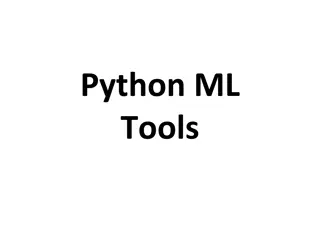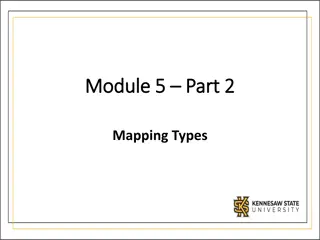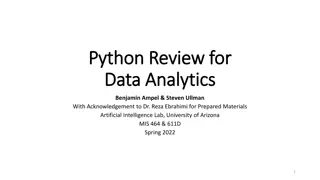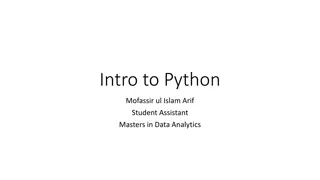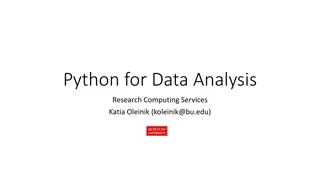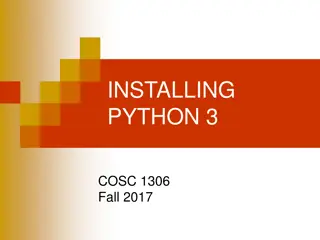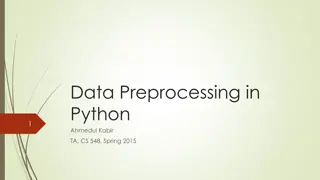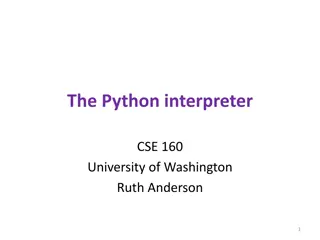Understanding NumPy for Efficient Data Analysis in Python
NumPy is a foundational package for numerical computing in Python, essential for data analysis and machine learning projects. It provides efficient multidimensional arrays for fast arithmetic operations, mathematical functions, tools for data manipulation, and integration with other languages. This article explores the advantages of NumPy arrays over lists and demonstrates how to create NumPy arrays from Python lists.
Download Presentation

Please find below an Image/Link to download the presentation.
The content on the website is provided AS IS for your information and personal use only. It may not be sold, licensed, or shared on other websites without obtaining consent from the author. Download presentation by click this link. If you encounter any issues during the download, it is possible that the publisher has removed the file from their server.
E N D
Presentation Transcript
Data Analysis and Visualisation with Python Q-Step Workshop 06/11/2019 Lewys Brace l.brace@Exeter.ac.uk
Numerical Python (NumPy) NumPy is the most foundational package for numerical computing in Python. If you are going to work on data analysis or machine learning projects, then having a solid understanding of NumPy is nearly mandatory. Indeed, many other libraries, such as pandas and scikit-learn, use NumPy s array objects as the lingua franca for data exchange. One of the reasons as to why NumPy is so important for numerical computations is because it is designed for efficiency with large arrays of data. The reasons for this include: - It stores data internally in a continuous block of memory, independent of other in-built Python objects. - It performs complex computations on entire arrays without the need for for loops.
What youll find in NumPy ndarray: an efficient multidimensional array providing fast array-orientated arithmetic operations and flexible broadcasting capabilities. Mathematical functions for fast operations on entire arrays of data without having to write loops. Tools for reading/writing array data to disk and working with memory- mapped files. Linear algebra, random number generation, and Fourier transform capabilities. A C API for connecting NumPy with libraries written in C, C++, and FORTRAN. This is why Python is the language of choice for wrapping legacy codebases.
The NumPy ndarray: A multi-dimensional array object The NumPy ndarray object is a fast and flexible container for large data sets in Python. NumPy arrays are a bit like Python lists, but are still a very different beast at the same time. Arrays enable you to store multiple items of the same data type. It is the facilities around the array object that makes NumPy so convenient for performing math and data manipulations.
Ndarray vs. lists By now, you are familiar with Python lists and how incredibly useful they are. So, you may be asking yourself: I can store numbers and other objects in a Python list and do all sorts of computations and manipulations through list comprehensions, for- loops etc. What do I need a NumPy array for? There are very significant advantages of using NumPy arrays overs lists.
Creating a NumPy array To understand these advantages, lets create an array. One of the most common, of the many, ways to create a NumPy array is to create one from a list by passing it to the np.array() function. In: Out:
Differences between lists and ndarrays The key difference between an array and a list is that arrays are designed to handle vectorised operations while a python lists are not. That means, if you apply a function, it is performed on every item in the array, rather than on the whole array object.
Lets suppose you want to add the number 2 to every item in the list. The intuitive way to do this is something like this: In: Out: That was not possible with a list, but you can do that on an array: In: Out:
It should be noted here that, once a Numpy array is created, you cannot increase its size. To do so, you will have to create a new array.
Create a 2d array from a list of list You can pass a list of lists to create a matrix-like a 2d array. In: Out:
The dtype argument You can specify the data-type by setting the dtype() argument. Some of the most commonly used NumPy dtypes are: float, int, bool, str, and object. In: Out:
The astype argument You can also convert it to a different data-type using the astype method. In: Out: Remember that, unlike lists, all items in an array have to be of the same type.
dtype=object However, if you are uncertain about what data type your array will hold, or if you want to hold characters and numbers in the same array, you can set the dtype as 'object'. In: Out:
The tolist() function You can always convert an array into a list using the tolist() command. In: Out:
Inspecting a NumPy array There are a range of functions built into NumPy that allow you to inspect different aspects of an array: In: Out:
Extracting specific items from an array You can extract portions of the array using indices, much like when you re working with lists. Unlike lists, however, arrays can optionally accept as many parameters in the square brackets as there are number of dimensions In: Out:
Boolean indexing A boolean index array is of the same shape as the array-to-be-filtered, but it only contains TRUE and FALSE values. In: Out:
Pandas Pandas, like NumPy, is one of the most popular Python libraries for data analysis. It is a high-level abstraction over low-level NumPy, which is written in pure C. Pandas provides high-performance, easy-to-use data structures and data analysis tools. There are two main structures used by pandas; data frames and series.
Indices in a pandas series A pandas series is similar to a list, but differs in the fact that a series associates a label with each element. This makes it look like a dictionary. If an index is not explicitly provided by the user, pandas creates a RangeIndex ranging from 0 to N-1. Each series object also has a data type. In: Out :
As you may suspect by this point, a series has ways to extract all of the values in the series, as well as individual elements by index. In: Out : You can also provide an index manually. In: Out:
It is easy to retrieve several elements of a series by their indices or make group assignments. Out: In:
Filtering and maths operations Filtering and maths operations are easy with Pandas as well. In: Out :
Pandas data frame Simplistically, a data frame is a table, with rows and columns. Each column in a data frame is a series object. Rows consist of elements inside series. Case ID Variable one Variable two Variable 3 1 123 ABC 10 2 456 DEF 20 3 789 XYZ 30
Creating a Pandas data frame Pandas data frames can be constructed using Python dictionaries. In: Out:
You can ascertain the type of a column with the type() function. In: Out:
A Pandas data frame object as two indices; a column index and row index. Again, if you do not provide one, Pandas will create a RangeIndex from 0 to N-1. In: Out:
There are numerous ways to provide row indices explicitly. For example, you could provide an index when creating a data frame: In: Out: or do it during runtime. Here, I also named the index country code . Out: In:
Row access using index can be performed in several ways. First, you could use .loc() and provide an index label. Out: In: Second, you could use .iloc() and provide an index number Out: In:
A selection of particular rows and columns can be selected this way. In: Out: You can feed .loc() two arguments, index list and column list, slicing operation is supported as well: In: Out:
Filtering Filtering is performed using so-called Boolean arrays.
Deleting columns You can delete a column using the drop() function. In: Out: In: Out:
Reading from and writing to a file Pandas supports many popular file formats including CSV, XML, HTML, Excel, SQL, JSON, etc. Out of all of these, CSV is the file format that you will work with the most. You can read in the data from a CSV file using the read_csv() function. Similarly, you can write a data frame to a csv file with the to_csv() function.
Pandas has the capacity to do much more than what we have covered here, such as grouping data and even data visualisation. However, as with NumPy, we don t have enough time to cover every aspect of pandas here.
Exploratory data analysis (EDA) Exploring your data is a crucial step in data analysis. It involves: Organising the data set Plotting aspects of the data set Maybe producing some numerical summaries; central tendency and spread, etc. Exploratory data analysis can never be the whole story, but nothing else can serve as the foundation stone. - John Tukey.
Download the data Download the Pokemon dataset from: https://github.com/LewBrace/da_and_vis_python Unzip the folder, and save the data file in a location you ll remember.
Reading in the data First we import the Python packages we are going to use. Then we use Pandas to load in the dataset as a data frame. NOTE: The argument index_col argumentstates that we'll treat the first column of the dataset as the ID column. NOTE: The encoding argument allows us to by pass an input error created by special characters in the data set.
We could spend time staring at these numbers, but that is unlikely to offer us any form of insight. We could begin by conducting all of our statistical tests. However, a good field commander never goes into battle without first doing a recognisance of the terrain This is exactly what EDA is for
Bins You may have noticed the two histograms we ve seen so far look different, despite using the exact same data. This is because they have different bin values. The left graph used the default bins generated by plt.hist(), while the one on the right used bins that I specified.
There are a couple of ways to manipulate bins in matplotlib. Here, I specified where the edges of the bars of the histogram are; the bin edges.
You could also specify the number of bins, and Matplotlib will automatically generate a number of evenly spaced bins.
Seaborn Matplotlib is a powerful, but sometimes unwieldy, Python library. Seaborn provides a high-level interface to Matplotlib and makes it easier to produce graphs like the one on the right. Some IDEs incorporate elements of this under the hood nowadays.
Benefits of Seaborn Seaborn offers: - Using default themes that are aesthetically pleasing. - Setting custom colour palettes. - Making attractive statistical plots. - Easily and flexibly displaying distributions. - Visualising information from matrices and DataFrames. The last three points have led to Seaborn becoming the exploratory data analysis tool of choice for many Python users.
Plotting with Seaborn One of Seaborn's greatest strengths is its diversity of plotting functions. Most plots can be created with one line of code. For example .
Histograms Allow you to plot the distributions of numeric variables.
Other types of graphs: Creating a scatter plot Name of our dataframe fed to the data= command Name of variable we want on the x-axis Name of variable we want on the y-axis Seaborn linear model plot function for creating a scatter graph
Seaborn doesn't have a dedicated scatter plot function. We used Seaborn's function for fitting and plotting a regression line; hence lmplot() However, Seaborn makes it easy to alter plots. To remove the regression line, we use the fit_reg=False command
The hue function Another useful function in Seaborn is the hue function, which enables us to use a variable to colour code our data points.












